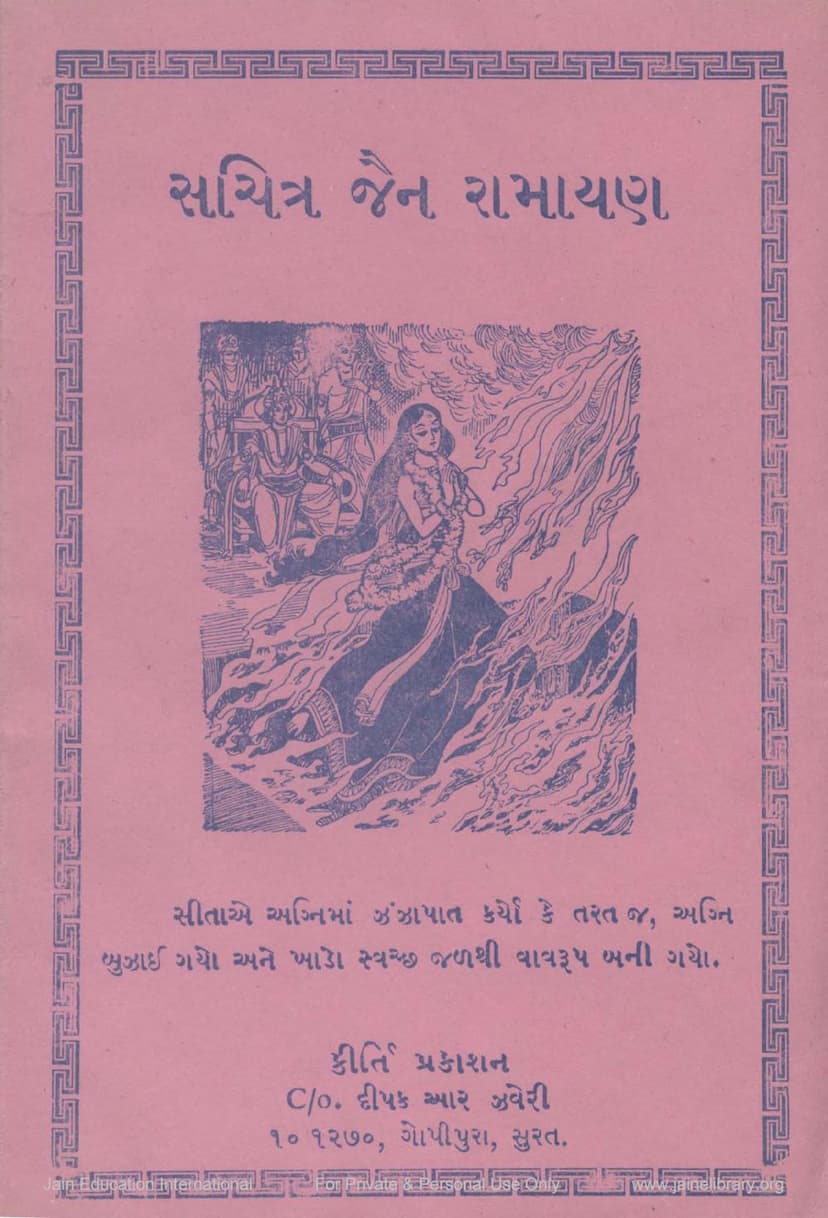Sachitra Jain Ramayan
Added to library: September 2, 2025

Summary
Here is a comprehensive summary of the "Sachitra Jain Ramayan" based on the provided Gujarati text:
Book Title: Sachitra Jain Ramayan (Illustrated Jain Ramayana) Author(s): Acharya Shri Chidanandsuri, Muni Shri Dharmghosh Maharaj Publisher: Kirti Prakashan Catalog Link: https://jainqq.org/explore/005130/1
This book, "Sachitra Jain Ramayan," aims to present the story of Rama and its associated characters and events from a Jain perspective, using an accessible style and illustrations to make it appealing, especially to children. The editorial section highlights the popularity of the Ramayana in contemporary media (like TV serials) but questions the extent to which viewers imbibe the virtues and cultural ideals presented. The authors' intention is to encourage readers to shape their lives according to these Jain ideals.
The text emphasizes that modern education, particularly in convent schools, is leading to a decline in traditional Indian values as children are influenced by Western culture. The book is presented as a means to counteract this trend by making the inspirational aspects of the Ramayana relatable and adoptable into daily life. It contrasts the current societal conflicts over status and wealth with the values of detachment, respect, and sacrifice exemplified in the Ramayana. The hope is that by reading and sharing this illustrated Jain Ramayana, children will learn about principles such as chastity, good conduct, brotherly love, discipline, and renunciation, thus making the effort successful.
The narrative then delves into the Jain version of the Ramayana's origins, tracing back the lineage of characters and events through the timelines of Jain Tirthankaras.
Key elements and narrative progression from the text:
- Ancestral Origins of Ravana: The story begins with a description of the lineage leading to Ravana, starting in the era of Ajitanath Prabhu. It details the kings of Lanka, the lineage of Vidyadhar kings, and the circumstances that led to the development of the Vanara (monkey) lineage and their association with Lanka.
- The Story of Shrikanth and Padya: This section recounts the love story of Shrikanth, son of Vidyadhar King Ati, and Padya, daughter of King Puttar. It explains how their union and the subsequent events led to the establishment of a lineage that would eventually be linked to the Ramayana narrative.
- The Tale of Vanodadhi and Tadikesh: The narrative shifts to the time of Suvrata Swami's Tirth, introducing King Vanodadhi of the Vanara lineage and Tadikesh, the Rakshasa king of Lanka. Their initial friendship and a subsequent incident involving a Rakshasa queen and a Vanara lead to a conflict. This conflict is traced back to past lives, highlighting the concepts of karma and reincarnation. Tadikesh eventually takes Jain Diksha (renunciation).
- The Ascendancy of Sukesh and the Lineage of Lanka: The story continues with the sons of Sukesh (brother of Shrikanth), who eventually take control of Lanka. It describes the lineage leading to Indrajit and Meghanada, and the establishment of the administrative structure of Lanka by Indrajit, appointing directional guardians from different regions.
- The Rise of Ravana: The text details the birth of Ravana (initially named Dashamukh), his gaining powers, his quest for knowledge, and his eventual coronation. It explains how Ravana's name came about due to the reflection of nine precious jewels on his face. The text also mentions the birth of his brothers Kumbhakarna and Vibhishana, and sister Shurpanakha.
- Ravana's Conquests (Digvijaya): Ravana's military campaigns are described, including his conflicts with Vaishravana (Kubera), Indra, and other rulers. His martial prowess and the acquisition of the Pushpak Vimana are highlighted. The text emphasizes Ravana's ambition and his eventual dominance over various kingdoms.
- The Story of Vali and Sugriva: The narrative introduces the Vanara kings Vali and Sugriva, their lineage, and their interaction with Ravana. The strength of Vali and his subsequent renunciation are described.
- The Past Lives of Ram, Lakshman, Sita, Hanuman, and Ravana: A significant portion of the text is dedicated to explaining the previous births (pūrva bhava) of the main characters. This involves intricate stories of their past actions, the karma generated, and how these actions led to their current births and roles in the Ramayana. This section highlights Jain ethical principles like non-violence, truthfulness, and the consequences of actions.
- The Birth of Rama and Lakshmana: The lineage of Ikshvaku dynasty and King Dasharatha is described, leading to the birth of Rama and Lakshmana. Their upbringing and initial interactions with Janaka are depicted.
- The Test of Sita's Purity: The narrative covers the events leading to Sita's exile, the public accusation of her character, and her eventual ordeal by fire (Agni Pariksha) to prove her chastity. The text presents this from a Jain perspective, where Sita's inner strength and adherence to Jain principles are emphasized.
- The Role of Other Characters: The stories of Hanuman, Vibhishana, Sugriva, and others are interwoven, explaining their origins and their roles in the larger narrative. Their past lives and karmic connections are also explored.
- The Death of Ravana and the Resolution: The climax of the story involves the battle between Rama and Ravana, with Lakshmana ultimately playing a crucial role in Ravana's defeat. The text details the process of Ravana's death and his subsequent rebirth in Naraka (hell).
- The Aftermath and Renunciation: Following Ravana's demise, the text describes the liberation of the captive characters, the return to Ayodhya, and the eventual renunciation and liberation of Rama, Lakshmana, Sita, Bharata, and other prominent figures. Their spiritual journeys and ultimate attainment of Moksha are mentioned.
Overall Theme:
The "Sachitra Jain Ramayan" is more than just a retelling of the epic; it is a didactic work designed to impart Jain philosophical and ethical teachings. It uses the familiar narrative of the Ramayana as a vehicle to explain complex concepts like karma, reincarnation, the importance of righteous conduct, renunciation, and the pursuit of liberation (Moksha). The illustrations are intended to enhance understanding and engagement, making these profound teachings accessible to a wider audience, particularly the younger generation.